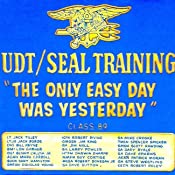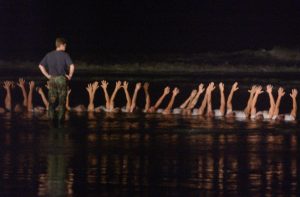You’ve probably heard the stories. The tales of impossible hardship and human endurance that come with Navy SEAL training are also known as BUD/S or BUDS. It’s a path that feels almost mythical, reserved for a special kind of person. Navy SEAL training is located in Coronado, CA, and for the fortunate 10-20% that survive, it lasts for 26 weeks. If you want one word to describe BUD/S, misery may be the best one-word description.
The reality behind the legend of Navy SEAL training is a structured, demanding, and incredibly long journey. It is built to find the few who simply will not quit. This process is the gateway to a challenging and rewarding Navy career in special operations.

Table of Contents:
- What It Really Means to Be a SEAL
- The Long and Grueling Path of Navy SEAL Training
- The Main Event: BUDS in Coronado
- The Broader Naval Special Warfare Community
- The Brutal Truth: Why So Few Make It
- What Does a Typical Mission Look Like?
- Conclusion
What It Really Means to Be a SEAL
Becoming a Navy SEAL is about more than just being in top physical shape. It’s a commitment to operating in the most difficult and dangerous situations imaginable. These operators are a key component of America’s special warfare capabilities.
Their missions are critical and varied. They include capturing high-value enemy targets and terrorists anywhere in the world. SEALs also conduct special reconnaissance, gathering vital intelligence quietly and unseen.
Sometimes, they are called on for small-unit, direct-action missions against military objectives. Before a larger force makes a landing from the sea, SEALs might perform underwater reconnaissance and demolish any obstacles in the way. This type of underwater demolition/SEAL work requires an incredible level of skill and courage.
A SEAL has to be ready to work in any environment on Earth. From blistering deserts and dense jungles to freezing arctic conditions, they adapt and overcome. They are masters of operating in urban areas, mountains, and woodlands, often with little support from a conventional force.
Teamwork is everything in the SEAL community. While each operator is highly capable on their own, they function as part of a seamless, tightly knit unit. Your life is literally in the hands of your teammates, and their lives are in yours.
Deployments are a regular part of Navy life for a SEAL team operator. You can expect to be away from home for six to eight months at a time, often in hostile territory. This life isn’t for everyone, and the training filters out anyone who isn’t 100% committed to the team and the mission.
The Long and Grueling Path of Navy SEAL Training
The entire process to become a Navy SEAL is a multi-year marathon, not a sprint. The six months spent at BUD/S are the part everyone talks about, but it’s just one piece of a much larger puzzle. The full pipeline weeds out the unprepared and finds the unbreakable.
It all starts long before you ever set foot in Coronado, California. For enlisted personnel, the journey begins at boot camp, learning to be a sailor first. You have to prove you have the basic physical foundation to even stand a chance at this demanding path.
The Starting Line: Qualifying for a Shot
Before you can get a ticket to Coronado for BUD/S, you have to pass the Physical Screening Test, or PST. Don’t be fooled by the numbers. Passing this test is the bare minimum, and most successful SEAL candidates far exceed these standards.
The test is a brutal sequence with very little rest between events. It measures your baseline fitness and your ability to keep going when you’re already tired. You have to perform each event back to back, testing your overall physical stamina and mental grit.
Here are the minimum requirements you’d need to meet, as outlined by official Navy guidelines. Keep in mind that competitive scores are much higher than these minimums, and simply meeting the minimums is not enough to be competitive.
| Event | Minimum Standard | Maximum Rest Time |
|---|---|---|
| 500-yard swim (sidestroke or breaststroke) | 12 minutes 30 seconds | 10 minutes |
| Push-ups in 2 minutes | 50 repetitions | 2 minutes |
| Sit-ups in 2 minutes | 50 repetitions | 2 minutes |
| Pull-ups in 2 minutes | 10 repetitions | 10 minutes |
| 1.5-mile run | 10 minutes 30 seconds | None |
Passing the PST doesn’t mean you’re ready for BUD/S. It just means you’ve earned the opportunity to begin the arduous training. The candidates who arrive best prepared can easily crush these numbers without hesitation.
Potential officers often come from service academies or other graduate opportunities. Regardless of the path, all SEAL candidates must demonstrate that they possess the physical and mental resilience required for what lies ahead.
The Main Event: BUD/S in Coronado
Basic Underwater Demolition/SEAL training, commonly referred to as BUD/S, is the core of the selection process. This six-month program, held in Coronado, California, will push you past every physical and mental boundary you have. It is overseen by a professional cadre of instructors and a duty officer responsible for daily operations.
The training is broken down into three phases. The first phase is the most infamous, focusing on basic physical conditioning, water competency, and teamwork. It’s here that the class size shrinks dramatically as candidates confront their limits.
This phase culminates in “Hell Week.” This is a five-and-a-half-day stretch where candidates are constantly cold, wet, hungry, and covered in sand. They get a total of about four hours of sleep for the entire week while performing non-stop physical tasks alongside their fellow sailors.
Phase Two focuses on combat diving and is where the basic underwater portion of the name originates. Candidates become experts in underwater skills and learn how to be comfortable and practical in the water for long periods. It’s a technical phase that requires a calm mind under immense pressure. The third and final phase covers land warfare. You’ll learn basic weapons handling, demolitions, rappelling, and small-unit tactics. By the end of BUDS, the few who remain have proven they have the raw materials to become a SEAL.
Beyond BUDS: Becoming a True Operator
Graduating from BUD/S is a considerable accomplishment, but the training is far from over. After BUD/S, you head to Parachute Jump School. Here, you’ll learn the skills needed for static line and free-fall parachuting from a fixed-wing aircraft.
Next is SEAL Qualification Training, also known as SQT. This is an advanced 26-week course that builds on everything you learned at BUDS. You’ll receive more in-depth instruction in weapons training, martial arts, cold-weather survival, and other advanced tactics, as well as communications and medical skills.
SQT is where you learn the skills that truly make you a deadly and effective operator. It refines raw potential into professional competence. This phase is less about pure physical attrition and more about mastering the complex skills required for special operations.
After completing SQT, you are awarded the Navy SEAL Trident. But even then, the training never stops. You will then be assigned to a SEAL Team for another 18 months of intensive pre-deployment training and specialized courses, a process often guided by an officer lead for the platoon.
The Broader Naval Special Warfare Community
While SEALs are the face of Naval Special Warfare, they are supported by a massive and highly professional team. A mission’s success depends on a wide array of specialists across the United States Navy. The career is demanding, but practical benefits, such as competitive military pay and comprehensive healthcare, are part of the package.
Logistics are handled by the supply corps, with a supply corps officer ensuring that teams have everything from ammunition to specialized gear. The Civil Engineer Corps is also essential, as civil engineers may design and build critical training facilities or forward operating bases. It takes a huge team to keep the spear sharp.
Even administrative functions are vital. The human resources department manages the complex personnel requirements for this elite community. A public affairs officer, meanwhile, serves as the liaison between the command and the public, carefully managing information.
Onboard support ships and sailors in various ratings are part of the team. A missile technician or damage control man ensures the vessel is ready for action. An electronics technician might work on the complex communication and sensor suites that provide teams with vital intelligence, while an interior communications electrician ensures shipboard systems are functional.

The Brutal Truth: Why So Few Make It
The numbers don’t lie. The attrition rate for seal training often hovers between 70% and 80%, and sometimes it is even higher. Most people who start the program will not finish it.
A majority of these candidates leave on their own terms. This is called Dropping on Request, or DOR. At any point, a candidate can decide they’ve had enough and go “ring the bell” three times, signaling their choice to quit.
This is what makes the training so powerful. It’s not always the biggest or strongest athletes who make it through. It’s the ones with the strongest minds who can endure the constant pressure and discomfort.
The instructors create an environment of controlled chaos. You are constantly under stress, sleep-deprived, and physically taxed. It’s all a test to see who can maintain focus, think clearly, and perform under the worst possible conditions imaginable.
What Does a Typical Mission Look Like?
There’s really no “typical” mission for a Navy SEAL. Versatility is central to their effectiveness. Insertion into a target area can happen in almost any way you can imagine.
An operation might start with a parachute jump from a high altitude, supported by a fixed-wing pilot and a naval flight officer who planned the route. Alternatively, a team could fast-rope down from a helicopter, relying on the skill of the helicopter pilot and the naval aircrewman avionics specialist to manage the complex electronic systems of the aircraft. This can be a tactical Romeo helicopter or another specialized platform.
Onboard a carrier, the aviation boatswain’s mate works tirelessly on the flight deck. The aircraft handling officer and catapult officer ensure a safe launch for planes providing mission support. This effort is coordinated with an air traffic controller managing the crowded airspace.
Aviation maintenance is also critical. An aviation maintenance duty officer oversees the teams that keep aircraft flying. These teams include specialists such as an aircrewman mechanic or an aircrewman operator, who are experts on their specific platforms. This meticulous support ensures the teams can get where they need to go.
Other missions could start with a ride in a high-speed boat operated by a boatswain’s mate or a quiet combat swimmer insertion from a submarine. Some missions begin with an extended foot patrol through enemy terrain. Not all sailors in the Navy have the same job; while a navy musician entertains the fleet, SEALs are training for direct action.
Once on the ground, SEALs operate with a level of precision and lethality that is respected worldwide. They rely on their extensive training, their state-of-the-art equipment, and, most importantly, each other. They are a brotherhood forged in the toughest training on the planet.
Conclusion
The path to earning the SEAL Trident is unimaginably complex. It is a slow, grinding process built to find men with a rare combination of physical prowess and unbreakable mental spirit. The challenges of Navy SEAL training strip away everything but a core desire to succeed and serve alongside the best.
It’s a journey that demands total commitment, a high tolerance for hardship, and an absolute refusal to quit. It requires a support system stretching across the entire Navy, from a fighter pilot to a technician maintenance specialist. Those who make it through emerge as some of the most capable and resilient warriors the world has ever known, ready for any mission, anywhere.
